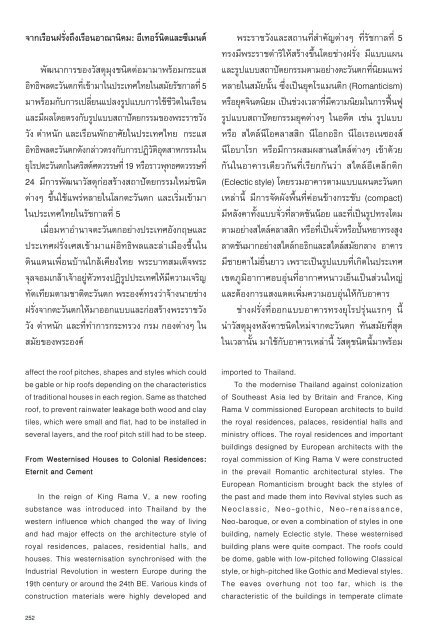บ้านเรือนถิ่นไทยในช่วงเจ็ดทศวรรษ 2489-2559
Create successful ePaper yourself
Turn your PDF publications into a flip-book with our unique Google optimized e-Paper software.
จากเรือนฝรั่งถึงเรือนอาณานิคม: อีเทอร์นิตและซีเมนต์<br />
พัฒนาการของวัสดุมุงชนิดต่อมามาพร้อมกระแส<br />
อิทธิพลตะวันตกที่เข้ามาในประเทศไทยในสมัยรัชกาลที่ 5<br />
มาพร้อมกับการเปลี่ยนแปลงรูปแบบการใช้ชีวิตในเรือน<br />
และมีผลโดยตรงกับรูปแบบสถาปัตยกรรมของพระราชวัง<br />
วัง ตำหนัก และเรือนพักอาศัยในประเทศไทย กระแส<br />
อิทธิพลตะวันตกดังกล่าวตรงกับการปฏิวัติอุตสาหกรรมใน<br />
ยุโรปตะวันตกในคริสต์ศตวรรษที่ 19 หรือราวพุทธศตวรรษที่<br />
24 มีการพัฒนาวัสดุก่อสร้างสถาปัตยกรรมใหม่ชนิด<br />
ต่างๆ ขึ้นใช้แพร่หลายในโลกตะวันตก และเริ่มเข้ามา<br />
ในประเทศไทยในรัชกาลที่ 5<br />
เมื่อมหาอำนาจตะวันตกอย่างประเทศอังกฤษและ<br />
ประเทศฝรั่งเศสเข้ามาแผ่อิทธิพลและล่าเมืองขึ้นใน<br />
ดินแดนเพื่อนบ้านใกล้เคียงไทย พระบาทสมเด็จพระ<br />
จุลจอมเกล้าเจ้าอยู่หัวทรงปฏิรูปประเทศให้มีความเจริญ<br />
ทัดเทียมตามชาติตะวันตก พระองค์ทรงว่าจ้างนายช่าง<br />
ฝรั่งจากตะวันตกให้มาออกแบบและก่อสร้างพระราชวัง<br />
วัง ตำหนัก และที่ทำการกระทรวง กรม กองต่างๆ ใน<br />
สมัยของพระองค์<br />
affect the roof pitches, shapes and styles which could<br />
be gable or hip roofs depending on the characteristics<br />
of traditional houses in each region. Same as thatched<br />
roof, to prevent rainwater leakage both wood and clay<br />
tiles, which were small and flat, had to be installed in<br />
several layers, and the roof pitch still had to be steep.<br />
From Westernised Houses to Colonial Residences:<br />
Eternit and Cement<br />
In the reign of King Rama V, a new roofing<br />
substance was introduced into Thailand by the<br />
western influence which changed the way of living<br />
and had major effects on the architecture style of<br />
royal residences, palaces, residential halls, and<br />
houses. This westernisation synchronised with the<br />
Industrial Revolution in western Europe during the<br />
19th century or around the 24th BE. Various kinds of<br />
construction materials were highly developed and<br />
พระราชวังและสถานที่สำคัญต่างๆ ที่รัชกาลที่ 5<br />
ทรงมีพระราชดำริให้สร้างขึ้นโดยช่างฝรั่ง มีแบบแผน<br />
และรูปแบบสถาปัตยกรรมตามอย่างตะวันตกที่นิยมแพร่<br />
หลายในสมัยนั้น ซึ่งเป็นยุคโรแมนติก (Romanticism)<br />
หรือยุคจินตนิยม เป็นช่วงเวลาที่มีความนิยมในการฟื้นฟู<br />
รูปแบบสถาปัตยกรรมยุคต่างๆ ในอดีต เช่น รูปแบบ<br />
หรือ สไตล์นีโอคลาสสิก นีโอกอธิก นีโอเรอเนซองส์<br />
นีโอบาโรก หรือมีการผสมผสานสไตล์ต่างๆ เข้าด้วย<br />
กันในอาคารเดียวกันที่เรียกกันว่า สไตล์อีเคล็กติก<br />
(Eclectic style) โดยรวมอาคารตามแบบแผนตะวันตก<br />
เหล่านี้ มีการจัดผังพื้นที่ค่อนข้างกระชับ (compact)<br />
มีหลังคาทั้งแบบจั่วที่ลาดชันน้อย และที่เป็นรูปทรงโดม<br />
ตามอย่างสไตล์คลาสสิก หรือที่เป็นจั่วหรือปั้นหยาทรงสูง<br />
ลาดชันมากอย่างสไตล์กอธิกและสไตล์สมัยกลาง อาคาร<br />
มีชายคาไม่ยื่นยาว เพราะเป็นรูปแบบที่เกิดในประเทศ<br />
เขตภูมิอากาศอบอุ่นที่อากาศหนาวเย็นเป็นส่วนใหญ่<br />
และต้องการแสงแดดเพิ่มความอบอุ่นให้กับอาคาร<br />
ช่างฝรั่งที่ออกแบบอาคารทรงยุโรปรุ่นแรกๆ นี้<br />
นำวัสดุมุงหลังคาชนิดใหม่จากตะวันตก ทันสมัยที่สุด<br />
ในเวลานั้น มาใช้กับอาคารเหล่านี้ วัสดุชนิดนี้มาพร้อม<br />
imported to Thailand.<br />
To the modernise Thailand against colonization<br />
of Southeast Asia led by Britain and France, King<br />
Rama V commissioned European architects to build<br />
the royal residences, palaces, residential halls and<br />
ministry offices. The royal residences and important<br />
buildings designed by European architects with the<br />
royal commission of King Rama V were constructed<br />
in the prevail Romantic architectural styles. The<br />
European Romanticism brought back the styles of<br />
the past and made them into Revival styles such as<br />
Neoclassic, Neo-gothic, Neo-renaissance,<br />
Neo-baroque, or even a combination of styles in one<br />
building, namely Eclectic style. These westernised<br />
building plans were quite compact. The roofs could<br />
be dome, gable with low-pitched following Classical<br />
style, or high-pitched like Gothic and Medieval styles.<br />
The eaves overhung not too far, which is the<br />
characteristic of the buildings in temperate climate<br />
252


















